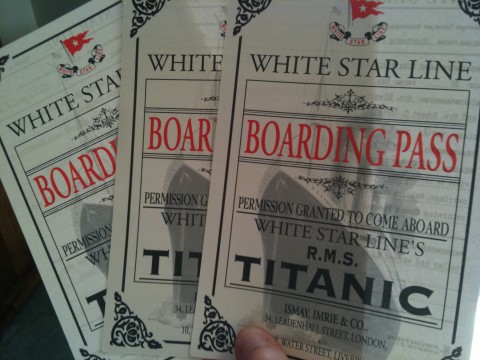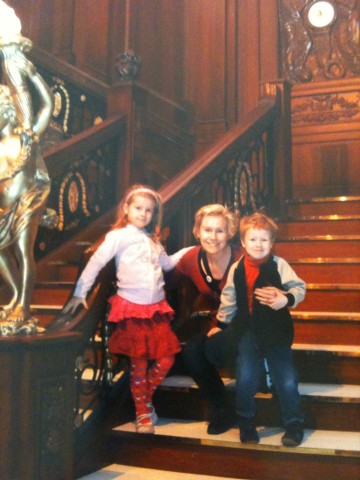Back in June* I took the kids to see the Titanic Exhibition at the Melbourne Museum. I was hoping the place would be nice and quiet because it was a school day (except for Keira’s, who were having a pupil-free day).
I was wrong.
Luckily, we’d booked ahead to go in the earliest (10am) session, so as soon as the doors opened we went downstairs and were quickly inside. We were able to do this because I’d booked online and printed out the tickets, thus bypassing all the queues at the main ticket desks. I advise everyone else to do the same, if possible!
When you go in you’re handed a boarding pass like this:

On the back you find a profile of a Titanic passenger, their vital statistics, short biography, etc. But not their date of death. You can then – if you’re curious – go up to a giant list towards the end of the exhibition which has all of the passengers (and crew) and whether they died or not. More on our fates later.
Before we went I’d been warned by other families that some sensitive children found the exhibition disturbing in places. I can see why, especially at some of the video footage that shows re-enactments of the final breaking up and sinking of the ship. My children, though, weren’t fazed. And to be honest, they weren’t all that interested in the artefacts either, and it was painful for me to pulled along at a quicker pace than I would’ve gone solo. But there were a few things that snagged their imaginations: frail wallets containing money and pieces of paper with identifiable writing, crumpled stewards jackets, a shoe, buttons. The pieces of ephemera they could actually identify with, more than rusted pieces of hull, or ships rivets.
Then we came to this room: the reconstructed Grand Staircase – and my thoughts went to the Titanic movie, I admit.

All reconstructed pieces and sets were impressive but what I liked most of all, and was the most moving, was what the kids called “The Iceberg Room”. It had a wall made of ice that you were free to put your hands on and touch. The room is dark, with flashes of blue. On the walls are quotes about the moment of impact, many contradicting the other. Next to the big ice block is a sign that said most of the victims didn’t die from drowning, they died from hypothermia.
While we were in that room, a bunch of high school boys came in, joking and poking one another, having fun. They were drawn – as we all were – to the ice wall. As they touched it, and then read the sign, they each became silent for a moment, reflecting on the words, because they were experiencing it too, if only in part.
One boy pulled back his hand and trailed a finger over the water left in his palm, in contemplation.
That was powerful and I was brought to tears. I’d been close for some time.
It is a sad exhibition. Because the kids were impatient to be out of there, I forgot to check whether “we” (on our boarding passes) had survived or not. Later, at home, I checked online (I googled names).
“My” person survived. “Keira” and “Riley’s” perished.
I sat there and felt terribly moved. I couldn’t understand why that would’ve affected me. After all, most people died. “I” was lucky to have survived for “I” was a B-Class passenger. “Keira”, for example, was a wealthy A-Class passenger. But then I suppose it reminds us to value our lives. As we should.
Titanic: The Artefact Exhibition runs until October 17th.
Tickets may be purchased here.
We paid for this trip ourselves, right down to that Grand Staircase picture.
* Yes, June. Forgive me, I’ve been busy.



















